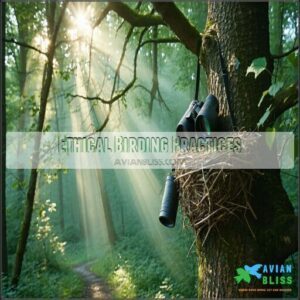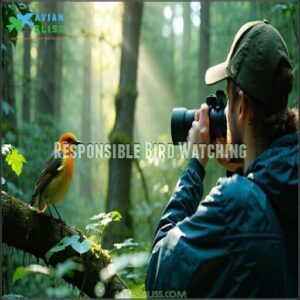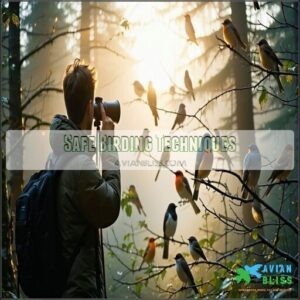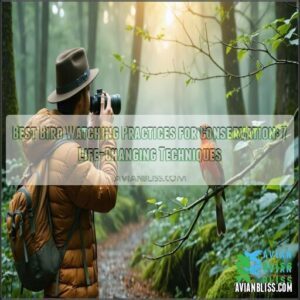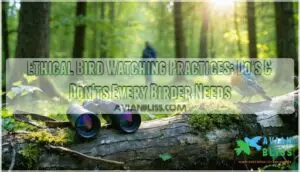This site is supported by our readers. We may earn a commission, at no cost to you, if you purchase through links.

Stay on trails to protect habitats, and avoid getting too close to nests or roosting spots—disturbances can stress birds.
Skip the flash on your camera, as it could startle them, and birds hear better than you might think, so keep noise low and move carefully.
Pack out all trash and leave no trace to preserve their environment, and patience is key—relax, enjoy the moment, and let the birds come to you, because isn’t nature’s best show worth the wait?
Table Of Contents
- Key Takeaways
- Bird Watching Basics
- Birding Without Harm
- Ethical Birding Practices
- Responsible Bird Watching
- Safe Birding Techniques
- Frequently Asked Questions (FAQs)
- Is there a right way to Birdwatch?
- Does birdwatching cause harm?
- What does birdwatching really mean?
- Why is birdwatching important?
- Is birdwatching ethical?
- Is bird watching unintrusive?
- What is the best way to bird watch?
- How to get rid of birds without harming them?
- What colors not to wear for birding?
- What are the 5 S’s of birding?
- Conclusion
Key Takeaways
- Keep your distance and use binoculars or telephoto lenses to observe birds without disturbing them.
- Stay on trails to protect habitats and avoid getting too close to nests or roosting spots.
- Skip flash photography and minimize noise to prevent startling birds.
- Pack out all trash and practice leave-no-trace principles to preserve the environment.
Bird Watching Basics
When you’re starting out with bird watching, it’s all about being quiet and respectful of the birds’ space.
Be calm, move gently, and let nature reveal its beauty—bird watching thrives on respect and quiet patience.
With a bit of patience and simple tools like binoculars, you can enjoy the beauty of birds without causing them harm.
Minimizing Disturbance to Birds
Even small actions can make a big difference in responsible birding. Keep noise down and minimize bird disturbance by moving slowly and quietly.
Watch for agitation signs like fluttering or alarm calls, then back away. Follow ethical viewing and distance guidelines to avoid stressing birds.
- Silence your phone to reduce noise.
- Avoid flash photography.
- Stay on trails for habitat protection.
- Observe quietly at safe distances.
Respecting Bird Habitats
Respecting bird habitats means sticking to trails and avoiding areas where birds nest or roost.
Trampling vegetation or disturbing soil can harm fragile ecosystems.
Think of yourself as a guest in their home—don’t rearrange the furniture.
Follow sustainable practices to protect bird habitats and support habitat preservation.
Here’s how you can help:
| Action | Why It Matters |
|---|---|
| Stay on trails | Protects delicate plant life |
| Avoid nesting areas | Reduces stress on birds |
| Respect conservation policies | Guarantees ecosystem health |
| Pack out all trash | Promotes habitat preservation |
| Support restoration efforts | Aids in habitat restoration |
By following these actions, you contribute to the well-being of bird habitats and the environment as a whole, which is crucial for ecosystem health and delicate plant life.
Understanding Bird Behavior
Watching bird behavior helps you connect with their world.
Observe the subtle rhythms of bird behavior and discover the stories they share through movement, calls, and quiet beauty.
Learn how birds communicate through call variations and body language—these show mood or stress signals.
Observe migration patterns, social structures, or foraging strategies to spot subtle routines.
During mating rituals, respect space, as alarm calls signal discomfort.
Understanding these habits makes bird watching richer without causing harm.
For species identification, consider using compact field guides.
Birding Without Harm
When birding, it’s not just about what you see—it’s about how you honor the birds and their environment.
To truly embrace responsible birding, focus on minimizing disturbance. Move gently, speak softly, and enjoy the quiet of nature.
Ethical birding means respecting their space, particularly during breeding seasons or near nesting sites. Stick to trails to protect fragile habitats, and avoid flashy gear that might startle them.
Ethical photography can capture stunning moments without harming birds—skip the flash and keep your distance. Share your sightings thoughtfully; responsible reporting avoids revealing sensitive locations.
You can also support bird conservation with citizen science projects or advocacy efforts. Remember, bird ethics isn’t about perfect behavior—just consistent care and awareness while enjoying nature.
Ethical Birding Practices
You can enjoy birdwatching responsibly by following key ethical practices that protect birds and their habitats.
Use gear like binoculars to keep a safe distance, avoid loud noises, and respect nesting sites to guarantee you’re not causing any harm, by also following key ethical practices.
Using Binoculars and Telephoto Lenses
Choosing the right binoculars or telephoto lens makes ethical birding easier.
Balance magnification vs. field of view; too much zoom narrows your scope. Look for lens coatings to reduce glare and improve clarity.
Image stabilization and ergonomic design help when handheld, but a tripod minimizes disturbance.
Consider birding binoculars’ ethics before purchasing equipment. Invest in quality gear for responsible birding, keeping wildlife comfortable while you stay captivated.
Maintaining Safe Distances
Keeping a respectful distance is key to safe bird watching and minimizing disturbance.
Birds may show stress signs by fluttering nervously or calling repeatedly. Use binoculars or telephoto lenses to observe them without getting too close.
To maintain ethical birding, follow these guidelines:
- Stay 30+ feet away from nests.
- Avoid sudden movements.
- Watch silently.
- Back away if birds look agitated.
- Prioritize bird welfare over convenience.
Avoiding Flash Photography
Avoid flash photography to prioritize bird wellbeing and practice ethical birding. Flashes may startle birds, especially during breeding seasons or with nocturnal birds sensitive to flash impact in low-light conditions.
Instead, rely on natural light or high ISO settings. Respect bird photography ethics, avoiding baiting or luring. Ethical photography guarantees birds stay undisturbed, allowing natural behaviors to flourish.
| Problem | Why It Matters | Alternative Techniques | Benefits |
|---|---|---|---|
| Flashes startle birds | Disrupts natural behaviors | Use natural light | Birds stay calm and active |
| Low-light photography | Difficult without flash | Increase ISO, use tripod | Clear photos, no disturbance |
| Nocturnal birds | Sensitive to sudden light | Rely on moonlight exposure | Maintains night routines |
| Maintaining ethics | Essential for bird wellbeing | Avoid flashes and luring | Encourages ethical behavior |
Respecting Nesting Sites
Respecting nesting sites is key to ethical birding. Birds, especially during breeding season, are sensitive to nesting disturbance. Keep your distance and observe quietly.
- Stick to trails to protect nesting habitats.
- Use ethical photography by avoiding flash and staying far enough away.
- Learn nesting behavior, so you recognize when birds are stressed and can back off.
Support habitat protection for bird conservation. Remember to adhere to ethical bird watching for conservation.
Responsible Bird Watching
When you watch birds responsibly, you protect their habitats and make certain they feel secure. By staying mindful of your actions, you can minimize disturbance while enjoying their natural behaviors.
Leaving No Trace
After respecting nesting sites, focus on leaving no trace. Minimize waste by packing out all trash and belongings, including food wrappers.
Proper disposal of items is key to habitat preservation. Stick to trails to reduce your footprint, and respect nature by avoiding vegetation damage.
Ethical birding means following birdwatching etiquette and minimizing disturbance, ensuring future generations enjoy birdwatching too. Remember to practice ethical bird watching to minimize disturbance.
Reducing Environmental Impact
Reducing your environmental footprint makes birding even better.
Stick to these tips:
- Pack reusable gear to cut waste—skip single-use plastics.
- Use eco-friendly soap if cleaning near water sources; protect habitats.
- Ride-share or bike to birding spots for climate action.
- Conserve water by avoiding excessive rinsing—birds appreciate balanced ecosystems.
Small changes, big impact—birds will thank you for taking small changes and making a big impact!
Conserving Bird Habitats
Conserving bird habitats starts with small steps like planting native flowers for bird-friendly habitats or joining citizen science projects.
Support habitat restoration by removing invasive plants or promoting climate action at home.
Here’s a quick guide:
| Action | Outcome | Examples |
|---|---|---|
| Habitat Restoration | Healthier ecosystems | Plant native trees, shrubs |
| Policy Advocacy | Protects nesting sites | Support bird-friendly laws |
| Invasive Control | Encourages biodiversity | Remove invasive species |
Save habitats, one step at a time, by taking small steps towards a bigger goal.
Supporting Bird Conservation Efforts
Supporting bird conservation efforts is easier than you think!
Engage with ethical birding practices and try these approaches:
- Join citizen science birding projects like eBird or Christmas Bird Count.
- Promote bird-friendly practices, like using bird-safe glass for windows.
- Advocate for habitat conservation policies through local action.
- Contribute to conservation funding by donating or buying bird-friendly certified products.
Your actions make a difference!
Safe Birding Techniques
To bird safely, you’ll need to combine the right tools, thoughtful location choices, and quiet observation techniques.
By practicing patience and respecting nature, you can enjoy incredible birdwatching moments without causing harm to birds or their habitats, which is crucial for incredible birdwatching experiences.
Choosing Right Equipment
Investing in the right gear makes birding joyful and ethical.
Binocular magnification like 8×42 keeps details sharp.
Lightweight cameras with zoom functions are ideal for distant shots.
Understanding binocular magnification options can greatly enhance your viewing experience.
A sturdy field bag organizes snacks and weather recording tools, while muted clothing guarantees quiet blends in.
These bird watching tips balance comfort, functionality, and bird-friendly practices.
The key to a successful birding experience is finding the right balance between comfort, functionality, and respect for the birds’ environment.
| Equipment | Purpose | Example | Bird-Friendly Practice |
|---|---|---|---|
| Binoculars | Clear, distant views | 8×42 magnification | Observe without disturbing |
| Camera | Discreet bird photography | Lightweight zoom | Avoids unnecessary movement |
| Field Bag | Organizes essentials | Waterproof material | Keeps snacks/noise secure |
| Clothing | Blends seamlessly | Muted, UV-resistant | Minimizes visual distractions |
Selecting Birding Locations
Finding the right birdwatching locations makes all the difference. Explore habitat diversity by visiting birdwatching parks, trails, or reserves.
Research seasonal trends to spot migrating species. Respect private property—don’t sneak around for a better view! Use satellite imagery to locate remote wetlands or woodlands for a quiet outing.
- Visit birdwatching parks for safe, scenic spots.
- Discover rare species in remote wetlands.
- Honor habitat conservation by staying on trails.
Attracting Birds Safely
When attracting birds safely, prioritize feeder hygiene and predator control.
Use native plants for food and shelter options, ensuring water sources are clean and accessible. Follow bird feeding guidelines, like maintaining safe feeding stations with a seed catcher accessory.
Bird-friendly gardening encourages visitors while protecting them. Install birdhouses at varying heights to protect from predators.
Keep shelters predator-free, and never overcrowd feeders—it’s all about balance and maintaining a safe environment with clean water sources.
Practicing Patience and Quiet Observation
Patience is your best tool for ethical birding. Begin with an acclimation period—stand still, breathe calmly, and let birds settle.
Move with silent steps, avoiding mimicry or sudden noise. Binocular prefocusing helps you spot details quickly without disrupting bird behavior.
Birdwatching observation is an art of subtlety, so give yourself time to minimize disturbance while truly connecting with nature.
Frequently Asked Questions (FAQs)
Is there a right way to Birdwatch?
You might worry about scaring birds, but birdwatching’s easy on them if you stay quiet, keep your distance, and follow trails.
Use binoculars, skip flash photography, and respect nesting areas for safe, guilt-free enjoyment.
Does birdwatching cause harm?
Birdwatching can harm birds if you’re noisy, get too close, or disrupt their habitats.
Following ethical guidelines, like staying on trails and keeping a respectful distance, guarantees you enjoy their beauty without causing stress, and by doing so, you can practice ethical birdwatching.
What does birdwatching really mean?
Birdwatching means observing birds in their natural habitats, enjoying their behaviors, songs, and beauty.
It’s about connecting with nature, sharpening your senses, and appreciating the incredible diversity of bird species around you.
Why is birdwatching important?
Birdwatching connects you to nature, promotes relaxation, and fosters conservation awareness.
It helps you appreciate biodiversity, supports ecological research, and inspires efforts to protect bird habitats, ensuring these fascinating creatures thrive for generations to come, which is crucial for their biodiversity.
Is birdwatching ethical?
Ethical birdwatching? It’s not about peeping on feathered celebrities with expensive binoculars.
Instead, you respect their space, tread lightly, avoid disturbing habitats, and leave no trace.
Simply put, you’re their quiet, respectful neighbor—not paparazzi.
Is bird watching unintrusive?
Yes, bird watching can be unintrusive if you’re mindful.
Keep a safe distance, stay quiet, avoid sudden movements, and skip the flashy gear.
Think of yourself as a respectful guest in their natural home.
What is the best way to bird watch?
Think of birdwatching as being a silent guest in nature’s concert.
Use binoculars for distance, tread softly, avoid sudden noises, stay on trails, and respect habitats.
Patience and quiet observation guarantee minimal disruption and maximum joy.
How to get rid of birds without harming them?
To gently deter birds, remove food sources, cover fruit trees with nets, and use reflective tape or wind chimes.
Seal entry points and place decoy predators like owls.
Keep it humane and harm-free!
What colors not to wear for birding?
Bright colors, like red, yellow, or white, can spook birds since they stand out.
Stick to earthy tones—greens, browns, or grays—to blend in.
Think of it as dressing like a quiet forest.
What are the 5 S’s of birding?
The 5 S’s of birding are: Stay quiet to avoid scaring birds, Stay still to blend in.
Scan for movement, Size up habitats for species.
Share observations responsibly without disrupting nature.
Conclusion
Bird watching is a gateway to nature’s finest symphony, but it’s essential to enjoy it ethically.
Keep your distance, use binoculars or a telephoto lens, and respect nesting areas to avoid disturbing birds.
Skip flash photography, stay quiet, and stick to trails to protect habitats.
Don’t leave behind trash—leave no trace instead.
By understanding how to bird watch without harming birds, you’ll create rewarding experiences while ensuring these incredible creatures thrive for years to come, and it is crucial to respect nesting areas.




